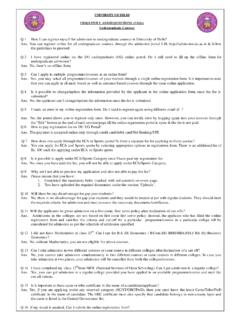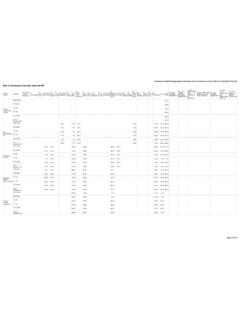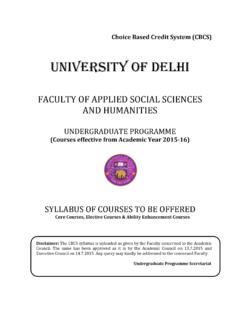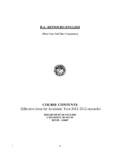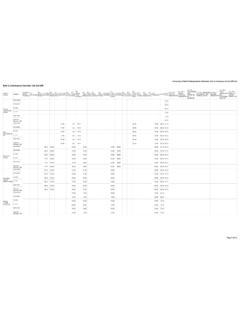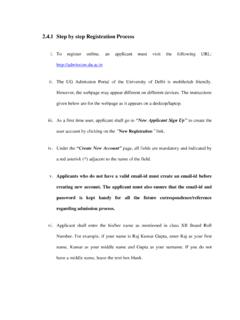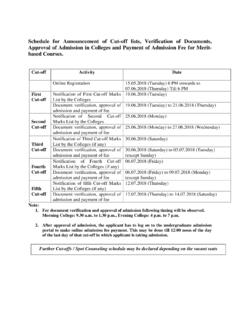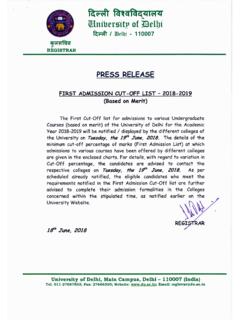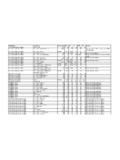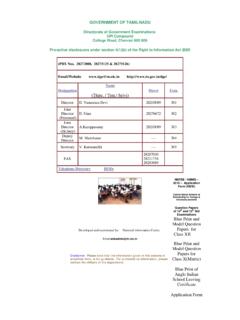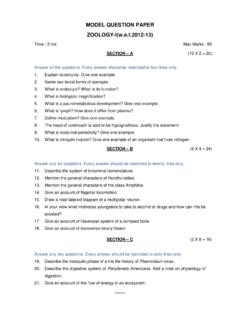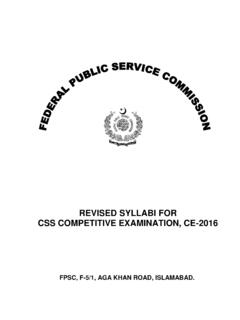Transcription of B.Sc. (H) ZOOLOGY - University of Delhi
1 (H) ZOOLOGY THREE-YEAR FULL-TIME PROGRAMME (Six-Semester Course) COURSE CONTENTS (Effective from the Academic Year 2010-2011) University OF Delhi Delhi 110 007 1 | P a g e Course Structure YEAR-1 PART I: Semester 1 Paper 1 LSPT 101 Biology-I(Introduction to Biology) Paper 2 ZOHT 101 Biodiversity I: Non-Chordata Paper 3 CHCT 301 Chemistry-I Paper 4 ENAT 101*/ CSAT 101* Technical Writing and Communication in English / Computational skills PART I: Semester 2 Paper 5 ZOHT 202 Biodiversity II: Chordata-I Paper 6 ZOHT 203 Biodiversity III: Chordata-II Paper 7 CHCT 402 Chemistry -II Paper 8 ENAT 201*/ CSAT 201* Technical writing and Communication in English / Computational skills *The college will have an option to take either of the two papers in a particular semester for a particular course, while students have to appear in both the papers In addition, there shall be one qualifying paper in self-learning mode called Environmental Studies offered in Semester-2 YEAR-2 PART II: Semester 3 Paper 9 ZOHT 304 Animal Physiology and Functional Histology -I Paper 10 MACT 303 Mathematics and Statistics Paper 11 CBHT 301 Cell Biology - I Paper 12 MBHT 301 Molecular Biology - 1 2 | P a g e PART II: Semester 4 Paper 13 ZOHT 405 Animal Physiology and Functional Histology-II Paper 14 ZOHT 406 Biochemistry Paper 15 CBHT 402 Cell Biology II Paper 16 MBHT 402 Molecular Biology - II YEAR-3 PART III.
2 Semester 5 Paper 17 ZOHT 507 Immunology Paper 18 ZOHT 508 Ecology Paper 19 ZOHT 509 Developmental Biology Paper 20 GGHT 501 Genetics & Genomics -I PART III: Semester 6 Paper 21 ZOHT 610 Evolutionary Biology Paper 22 ZOHT 611 Biotechnology Paper 23a/b/c ZOHT 612 / LSPT 409/ BTHT 509 Applied ZOOLOGY /Bioinformatics/ Environmental Management Paper 24 GGHT602 Genetics & Genomics - II 3 | P a g e PREAMBLE The ongoing (H) ZOOLOGY course was introduced by the Faculty of Sciences from the academic year 2005-2006. The new course that will be effective from the academic year 2010-2011, will follow the Semester mode. It has been prepared keeping in view the unique requirements of (H) ZOOLOGY students. The contents have been drawn-up to accommodate the widening horizons of the discipline of Biological Sciences. They reflect the current changing needs of the students; specifically, the subjects on Mathematics and Statistics and Computation skills have been included.
3 A special feature of this program has been the introduction of six new papers on Cell & Molecular Biology and Genetics that cover major disciplines in newer areas of Biological Sciences where a tremendous progress has been made during the past decade. A new paper on Biotechnology will also provide a glimpse of the application aspect. While the endeavor is to provide the student with the latest, nevertheless the classical ZOOLOGY has been given due weightage. The course content also lists the new practical exercises so that the students get a hands-on experience of the latest techniques that are in current usage. 4 | P a g e Paper 1-LSPT 101: BIOLOGY-I (INTRODUCTION TO BIOLOGY) THEORY Marks: 100 Unit 1: Biological systems, evolution and biodiversity a. Introduction to concepts of biology (Ch 1 Campbell) Themes in the study of biology; A closer look at ecosystem; A closer look at cell; The process of Science; Biology and everyday life b.
4 Evolutionary history of biological diversity (Ch 25 Campbell) Early earth and the origin of life; Major events in the history of life; Mechanism of Macroevolution; Phylogeny and the tree of life c. Classifying the diversity of life (Ch 25 Raven) Kingdoms of Life Prokaryotes, Eukaryotes, Archaea d. Darwinian view of life and origin of species (Ch22, 24 Campbell) Darwin s theory of evolution; The evolution of populations; Concepts of species; Mechanism of speciation e. Genetic approach to Biology (Ch 1 Griffiths) Patterns of inheritance and question of biology; Variation on Mendel s Law; The molecular basis of genetic information; The flow of genetic information from DNA to RNA to protein; Genetic Variation; Methodologies used to study genes and gene activities; Developmental noise; Detecting macromolecules of genetics; Model organisms for the genetic analysis; Distinction between Phenotype and Genotype Unit 2: Chemical context of living systems a.
5 Chemistry of life (Ch 2 Campbell) The constituents of matter; Structure of an atom; The energy level of electron; The formation and function of molecules depend on chemical bonding between atoms; Chemical reaction make or break chemical bonds b. Water and life (Ch 3 Campbell) The water molecule is polar; Properties of water; Ionization of water c. Carbon and life (Ch 4 Campbell) Organic chemistry3the study of carbon compounds; What makes carbon special? Properties of organic compounds d. Structure and function of biomolecules (Ch 5 Campbell) Most macromolecules are Polymers; Carbohydrates act as fuel and building materials; Lipids are group of hydrophobic molecules; Protein have diverse structures and functions; Nucleic acids store and transmit hereditary information 5 | P a g e LSPP 101: INTRODUCTION TO BIOLOGY PRACTICALS Marks: 50 1.
6 To learn a) use of microscope b) principles of fixation and staining. 2. Preparation of Normal, molar and standard solutions, phosphate buffers, serial dilutions 3. Use of micropipettes. 4. Separation of A) amino acids B) chloroplast pigments by paper chromatography. 5. To perform gram staining of bacteria. 6. To study the cytochemical distribution of nucleic acids and mucopolysaccharides with in cells/tissues from permanent slides. 7. To perform quantitative estimation of protein using the Lowry's method. Determine the concentration of the unknown sample using the standard curve plotted. 8. To separate and quantify sugars by thin layer chromatography. 9. To raise the culture of E. coli and estimate the culture density by turbidity. method. Draw a growth curve from the available data. 10. Isolation of genomic DNA from SUGGESTED BOOKS 1. Campbell, and Reece, J. B. (2008) Biology 8th edition, Pearson Benjamin Cummings, San Francisco.
7 2. Raven, et al (2006) Biology 7th edition Tata McGrawHill Publications, New Delhi 3. Griffiths, et al (2008) Introduction to Genetic Analysis, 9th edition, Freeman & Co. NY 6 | P a g e Paper 2-ZOHT 101: BIODIVERSITY-I NON-CHORDATA THEORY Marks: 100 General characters and outline classification of different phyla: Unit 1. Protozoa (Ch 2 Barnes) General characters and outline classification Locomotion and reproduction in Protozoa. Unit 2. Metazoa (Ch 3 Barnes) Origin of metazoa, metamerism and coelom. Unit 3. Phylum Porifera (Ch 4 Barnes) General characters and outline classification Structural organization of Sycon. Unit 4. Phylum Cnidaria (Ch 5 Barnes) General characters and outline classification Polymorphism in Cnidarians; corals and coral reefs Unit 5. Phylum Platyhelminthes (Ch 7 Barnes) General characters and outline classification Fasciola: life history; parasitic adaptations and evolution of parasitism Unit 6.
8 Phylum Aschelminthes (Ch 9 Barnes) General characters and outline classification Life history of Ascaris and its parasitic adaptations. Unit 7. Phylum Annelida (Ch 10 Barnes) General characters and outline classification Adaptive radiations in Polychaeta. Unit 8. Phylum Arthropoda (Ch 12, 13 Barnes) General characters and outline classification. Larval forms of crustacea; social life, moulting and metamorphosis in Insecta; vision in Arthropoda. Unit 9. Affinities of Onychophora Unit 10. Phylum Mollusca (Ch 11 Barnes) General characters and outline classification Torsion and detorsion; modifications of shell and foot Unit 11. Phylum Echinodermata (Ch 19 Barnes) General characters and outline classification Water3vascular system and larval forms 7 | P a g e ZOHP 101: BIODIVERSITY-I NON-CHORDATA PRACTICALS Marks: 50 Protozoa: 1.
9 Examination of Amoeba, Euglena, Paramecium, Ceratium, Noctiluca, and Vorticella. Porifera: 2. Study of Sycon (including and ). Hyalonema, and Euplectella; 3. Temporary mounts of spicules, gemmules and spongin fibres. Cnidaria: 4. Study of, Obelia, Sertularia, Physalia, Millepora, Aurelia, Scyphistoma and Ephyra larvae, Tubipora, Metridium (including and ). Platyhelminthes: 5. Study of Fasciola,, Taenia,, Echinococcus; life history and sections of Fasciola and Taenia Aschelminthes: 6. Study of male and female Ascaris (including sections). Annelida: 7. Dissections: digestive and nervous systems of earthworm. 8. Temporary mounts: Ovary, pharyngeal and septal nephridia of earthworm. 9. Slides: through pharynx, gizzard, and typhlosolar intestine of earthworm. 10. Specimens: Aphrodite, Heteronereis, Chaetopterus, Pheretima, Tubifex, Hirudinaria. Arthropoda: 11. Dissections: digestive and nervous systems of cockroach. 12. Temporary mounts: salivary glands and mouth parts of cockroach.
10 13. Specimens/slides: Limulus, spider, crustacean larvae, Daphnia, Balanus, Sacculina, Cancer, Eupagurus, Scolopendra, Julus, termite, louse, wasp, honeybee, silkmoth and Peripatus. Mollusca: 14. Dissections: digestive system of Pila; Temporary mounts3 radula and gill of Pila. 15. Specimens: Chiton, Dentalium, Unio, Ostrea, Teredo, Loligo, Sepia, Octopus and Nautilus. Echinodermata: 16. Slides: T. S. arm of Pentaceros, Echinoderm larvae. 17. Specimens: Pentaceros, Ophiura, Clypeaster, Echinu, Echinocardium, Cucumaria and Antedon. 8 | P a g e SUGGESTED BOOKS 1. Barnes, Invertebrate ZOOLOGY (1982) VI Edition. Holt Saunders International Edition. 2. Barnes, , Calow, P., Olive, , Golding, & , Spicer (2002) The Invertebrates: A New Synthesis. III Edition. Blackwell Science. 3. Barrington, (1979) Invertebrate Structure and Functions. II Edition. and Nelson. 4. Boradale, and Potts, (1961) Invertebrates: A Manual for the use of Students.
